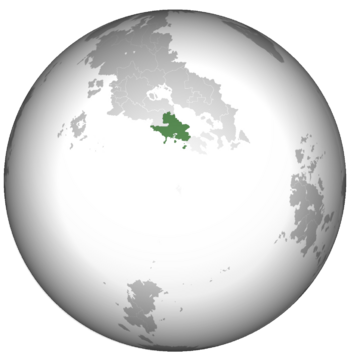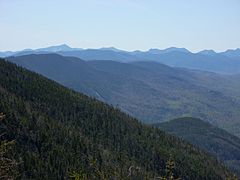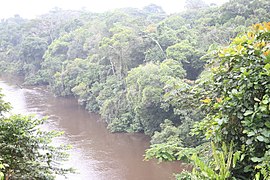Tierrador: Difference between revisions
mNo edit summary Tag: 2017 source edit |
No edit summary Tag: 2017 source edit |
||
| Line 115: | Line 115: | ||
''Who decides the laws for your country? Is there political parties and a legislature?'' | ''Who decides the laws for your country? Is there political parties and a legislature?'' | ||
===Federal subdivisions=== | ===Federal subdivisions=== | ||
[[File:Tierrador Regions Map.png|thumb|Map of the 19 mainland regions of Tierrador]] | |||
''Tierrador is divided into nineteen fully devolved regions, which are then separated into 75 provinces, all equally represented in the Senado de la República. For the Montaje Nacional, the body is made up by representatives determined by the populations of the provinces. Each of these regions were created by the Constitution of 1867, from the historical nine provinces, as it was regarded as much easier to govern the large nation with more devolution. These regions function as their own nations, where they are allowed to govern over their respective provinces, have their own parliaments and justice systems. They also possess partial fiscal autonomy, being able to create their own budgets and allocate resources for their Gross Domestic Products. In terms of defense, the Tierradorian regions have their own Regional Guard, which in turn is a division of the Tierradorian Defense Forces, and in the event of an armed conflict on Tierradorian soil, the Federal Government can temporarily dissolve and allow the regions to take control against the enemy.'' | ''Tierrador is divided into nineteen fully devolved regions, which are then separated into 75 provinces, all equally represented in the Senado de la República. For the Montaje Nacional, the body is made up by representatives determined by the populations of the provinces. Each of these regions were created by the Constitution of 1867, from the historical nine provinces, as it was regarded as much easier to govern the large nation with more devolution. These regions function as their own nations, where they are allowed to govern over their respective provinces, have their own parliaments and justice systems. They also possess partial fiscal autonomy, being able to create their own budgets and allocate resources for their Gross Domestic Products. In terms of defense, the Tierradorian regions have their own Regional Guard, which in turn is a division of the Tierradorian Defense Forces, and in the event of an armed conflict on Tierradorian soil, the Federal Government can temporarily dissolve and allow the regions to take control against the enemy.'' | ||
=== Politics=== | === Politics=== | ||
Revision as of 20:38, 30 April 2023
Tierradorian Republic República Tierradoriana (Spanish) | |
|---|---|
Motto: En el Señor confiamos ("In the Lord we trust") | |
Anthem: Tierrador | |
 Location of Tierrador (dark green) In Crona (gray) | |
| Capital and largest city | Taisgol |
| Official languages | Spanish English |
| Religion | 53% Christianity 21% no religion 12% Islam 8% Indigenous faith 6% Other |
| Demonym(s) | Tierradorian (noun) Tierradorian (adjective) |
| Government | Unitary Presidential Republic |
• President | Javier Cervantes |
• Premier | Francisco Pintón |
• Líder del Senado | Carlos Martínez |
| Legislature | Congreso de la República |
| Senado | |
| Montaje Nacional | |
| Establishment | |
• Tribal Kingdoms | 1030 AD |
• Colonization | 1548 - 1684 |
• Tierradorian Kingdom | 1684 - 1733 |
• Revolution of 1733 | October 9, 1733 |
• First Tierradorian Republic | 1733 - 1823 |
• Revolution of 1823 | January 9, 1823 |
• Tierradorian Imperial Provisionary Government | 1823 - 1867 |
• Revolution of 1867 | August 6, 1867 |
• Current Constitution and Republic | December 24, 1867 |
| Area | |
• Total | 2,041,817 km2 (788,350 sq mi) |
| Population | |
• Estimate | 101,604,230 |
• Census | 2021 |
| GDP (nominal) | estimate |
• Total | $2.7 trillion |
• Per capita | $26.573.70 |
| Gini | 26.6 low |
| Currency | Tsai (TDT) |
| Time zone | UTC—08:00 to UTC—10:00 |
| Mains electricity | 120 V–60 Hz |
| Driving side | right |
| Calling code | +31 |
| Internet TLD | .td |
Tierrador, officially the Tierradorian Republic, is a country primarily located in Southeastern Crona, along with a chain of islands in the Polynesian Sea. The country's mainland is bordered to the south by Ceylonia; to the south and west by the Sea of Orixtal; to the north by Istrenya and the Songun Sea; and to the west by Alstin and Pankara. Tierrador's capital is Taisgol, the largest city along with its commercial and cultural center; other major urban areas include Porvaos, Hugo, Auqali, Arroyo Rato, Prisamarina, San Luis, La Plazal, Las Rozas, and Aracadó. Tierrador is a member of the League of Nations and is considered a regional power within the Cronan continent, due to its strategic location and very powerful economy.
With a very high-developed and high quality standard of living, Tierrador is among one of the most powerful nations in the Cronan continent. It is considered a melting pot of cultures, due to the large amount of immigration into the nation in the late 70s to the early 90s. It also possesses one of the most powerful economies, with almost $3 trillion as its GDP. The country is divided into 19 regions, which equal to an area of 2,041,817 square kilometers and a population of just over 101 million. It is a unitary semi-presidential republic, with all of its governmental functions being held in the nation’s capital, Taisgol.
Tierrador is a prominent historical center of Cronan art, science and philosophy. It is one of the world’s leading tourist destinations, attracting over 76 million people from around the world yearly. It contains landmarks such as various temples dating back to the ancient Songun Civilization, the Palacio de Prosperidad (lit. Palace of Prosperity) in Taisgol, the many luscious and sandy beaches situated across the coastline of the mainland and the Tierradorian Polynesia, the mountainous northwestern region, and the unique pre-colonial architecture across the hilly Songun Coast.
Etymology
Tierrador is a combination of the Spanish phrase “Tierra del Oro” (lit. Land of Gold). The area was called this due to the various gold deposits found throughout the central and western areas of the nation.
History
What is a general overview of your country's path through history?
First era
How was your country originally settled?
Second era
What were the first political structures of your country? Did it have any very early rivals or was it controlled by a foreign country?
Third era
What were your country's first major moves on an international level?
Fourth era
Did your country ever have a period of significant decline or internal struggle?
Fifth era
Was your country subject to imperialism later in its life, or was it an imperial power?
Sixth era
How did the 20th century affect your country?
Geography
-
First lovely location
-
Second lovely location
-
Third lovely location
-
Fourth lovely location
-
Fifth lovely location
-
Sixth lovely location
What is the general explanation of how your country exists within the world?
Climate and environment
Is your country hot or cold?
Government and Politics
Tierrador is a federal semi-presidential republic. Its government center is in the capital Taisgol
Executive
Who is responsible for making high level choices in your country? Does it have a President or King?
Legislative
Who decides the laws for your country? Is there political parties and a legislature?
Federal subdivisions

Tierrador is divided into nineteen fully devolved regions, which are then separated into 75 provinces, all equally represented in the Senado de la República. For the Montaje Nacional, the body is made up by representatives determined by the populations of the provinces. Each of these regions were created by the Constitution of 1867, from the historical nine provinces, as it was regarded as much easier to govern the large nation with more devolution. These regions function as their own nations, where they are allowed to govern over their respective provinces, have their own parliaments and justice systems. They also possess partial fiscal autonomy, being able to create their own budgets and allocate resources for their Gross Domestic Products. In terms of defense, the Tierradorian regions have their own Regional Guard, which in turn is a division of the Tierradorian Defense Forces, and in the event of an armed conflict on Tierradorian soil, the Federal Government can temporarily dissolve and allow the regions to take control against the enemy.
Politics
What political factions exist? Who has ruled predominantly?
Law
What kind of laws and legal system does your country employ?
Demographics
What kind of people live in your country?
Ethnicity
Self-reported ethnic origin in the Tierradorian Republic (2021)
What ethnic groups make up your country?
Language
What language or languages do your country's people use? Are there any previously used languages no longer common? Are these languages native to your country or shared with another?
Religion
Religious affiliations in the Tierradorian Republic (2021)
What do your country's people believe in religiously, if anything? How many groups are there?
Education
How many people in your country are educated?
Culture and Society
What do your people do, and what are they like?
Education
What is your country's education system like? How do the schools work? What do people think about education?
Attitudes and worldview
How do your country's people view life?
Kinship and family
How are families or kinship groups structured in your country?
Cuisine
What do your people eat?
Religion
What do your people believe? Rather than demographics, as above, think about how important religion is to your people and their view about their own and other religions. What is the relationship between the prevailing view and minority religious groups? Is it an official religion, and do any laws exist about free worship?
Arts and Literature
What type of art do your people make? Do they have a tradition of painted art, well-crafted television shows, or great music?
Sports
Does your country have any major sports leagues? What types of sports are played, both professionally and for fun by your country's people?"
Symbols
Are there any prominent symbols which are well known to represent your country?
Economy and Infrastructure
How does your country's economy work?
Industries and Sectors
What are the largest parts of your economy in terms of what they do?
Currency
What exchange systems are used within your country's economy?
Healthcare
How do people in your country procure medical care? How is it paid for?
Labor
How is labor organized within your country? Are there any social institutions or unions which deal with labor concerns?
Transportation
How do people in your country get around? Is there a major highway system as well as sea- and airports?
Energy
What type of energy keeps your nation going? Are you renewable or use fossil fuels, and if you are renewable, how recently did your country transition?
Technology
How advanced is your country? Is it an innovator, or does it largely import new developments?
Military
How large is your country's military? Is it large but poorly equipped or small and elite? Does your country have a martial tradition?







